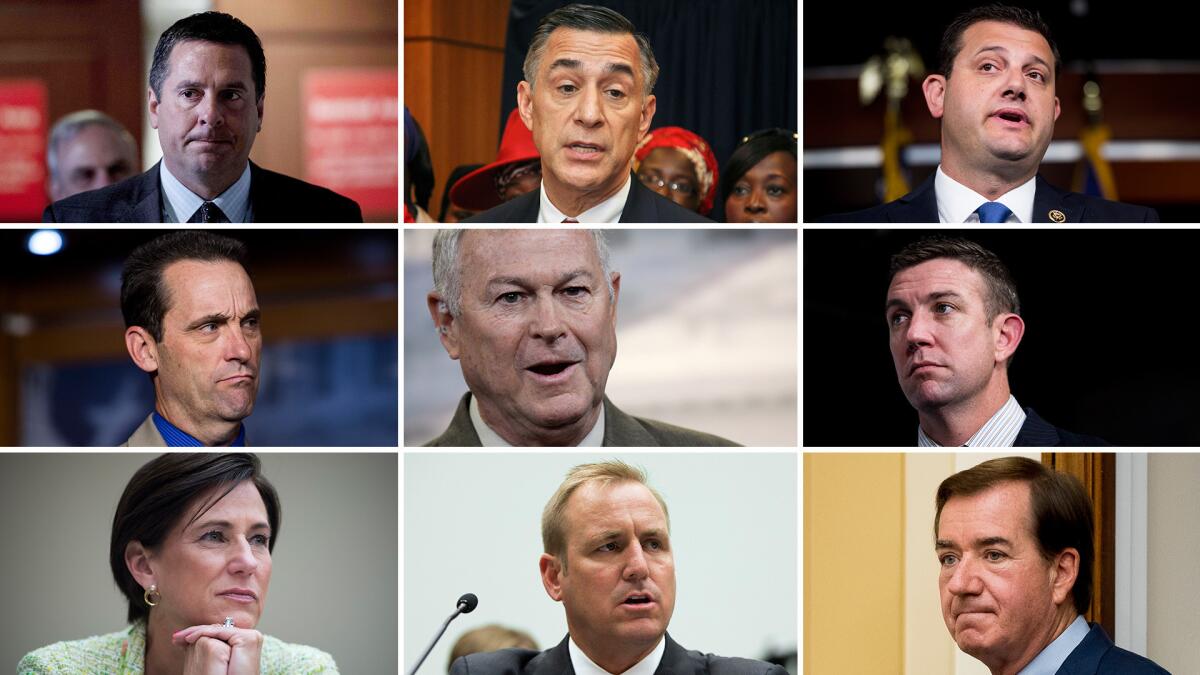Democrats’ road to winning back the House goes through California, and it won’t be as easy as it seems

- Share via
Democrats intent on taking back the House in 2018 have settled on a key strategy: focusing on the 23 districts nationwide where voters chose Republicans for Congress last year but favored Democrat Hillary Clinton over Donald Trump for the presidency. Seven of those seats are in California, and Democrats must win at least a few of them to have a shot at regaining power.
There are some reasons for Democrats to be optimistic. There’s been a surge of enthusiasm among the anti-Trump “resistance” at rallies and town halls, as well as a bumper crop of passionate Democratic challengers who have filed to run in California. The Democratic Congressional Campaign Committee has launched a satellite office in Orange County, a former bastion of conservatism that last year voted for a Democratic presidential candidate for the first time in 80 years and is home to four of the districts they’re eyeing.
But it might be a mistake to assume that strategy will be a panacea in California. Republican turnout in midterm elections often dwarfs Democratic turnout, and the rise of multiple viable candidates in many of the targeted districts threatens to mire them all in costly, divisive primary fights. A sampling of the outcomes for other races suggest Clinton’s victories there are at risk of being overplayed. Meanwhile, fighting within the California Democratic Party between left-leaning activists and the more centrist stalwarts who have traditionally had more success in swing districts could further damage Democrats’ chances.
If past is prologue, says Rob Pyers, research director for the nonpartisan election guide California Target Book, Democrats will have a hard time picking up more than a couple of seats in California.
Dozens of Democrats, many of them first-time candidates, have filed to run in closely watched races, raising money and further splitting the field. They run the gamut from more progressive Bernie Sanders supporters to business owners and veterans, and many have delicately toed the line on single-payer healthcare — an issue quickly becoming a potential litmus test for Democrats. Internal battles over the state party chairmanship and tension between more traditional liberals and business-aligned Democrats could threaten the unity needed to unseat GOP members.
While they fight, some Republican incumbents continue to build their campaign war chests. Rep. Mimi Walters (R-Irvine) and Rep. Ed Royce (R-Fullerton) have drawn more than a half dozen challengers each. Walters has $1.1 million, and Royce, a committee chairman, has $3.1 million.
“The conditions tend to favor the incumbents right now. There are very few in danger of actually flipping,” Pyers says.
Ignoring past voter behavior could put Democrats at risk of getting stuck in the same kind of bubble that led so many to believe Clinton would be elected president.
Even with the surge of Democratic turnout in last year’s presidential election, voters chose Republican incumbents despite less enthusiasm for Trump. Some Republican incumbents outperformed the president by double digits.
Democrats also can’t count on a similar surge in midterm elections. In some California districts, the drop-off in participation by younger and minority voters during midterms has been known to boost the GOP’s share of votes by as much as 9 percentage points, says Paul Mitchell, whose firm, Political Data Inc., provides voter data to campaigns.
Pyers and Target Book editor Darry Sragow recently published an analysis suggesting the 2016 presidential election results in some districts might have actually been flukes.
In the seven Republican-held districts in California that chose Clinton, results for ballot initiatives and statewide and presidential races going back to 2012 suggest voters there still lean much more conservative.
All seven districts supported a measure championed by anti-tax advocates that would have required voter approval of revenue bonds. The measure was defeated statewide thanks to large swaths of more liberal voters elsewhere. A ban on plastic bags that passed statewide was rejected by wide margins in six of the seven districts on the Democratic target list.
And in five of the seven districts, Clinton was the only Democratic candidate to carry the district in any statewide contest since 2012.
Republicans have also used their many wins in special elections across the country this year to point out that their core supporters can turn out in force when they perceive a threat.
And those races differ from 2018 in a major way: None of the candidates were running against incumbents, who are often better known, better funded and are reelected at least 90 percent of the time.
“California Republicans running up and down the state have great individual brands and are hyper-focused on their districts,” says Jack Pandol, a spokesman for the National Republican Congressional Committee. “I don’t take away from the Democrats that there’s enthusiasm on their side. But I think what’s been demonstrated this year in the four special elections is that our base can be activated and motivated as well.”
Still, those who study elections point out that relying on past data has its limits, particularly after a presidential election that was standard-breaking in so many ways.
“Every little bit of conventional wisdom was overturned in 2016,” says Sherry Bebitch Jeffe, a fellow at the USC Price School of Public Policy who has followed California politics for decades. “This is a far different political landscape than we have ever seen, and [Republicans] can’t take anything for granted.”
While Republicans have identified four Democrats they want to unseat in California, it isn’t clear they’ll be able to play both defense and offense in a state where the GOP has struggled at multiple levels.
If Trump’s job approval ratings in California remain in the gutter (a recent poll showed just 1 in 4 Californians approve of the job he’s doing), Republicans could face depressed turnout that will put more seats in play, says Gary Jacobson, a political scientist at UC San Diego. That could worsen further if the California GOP fails to field a viable candidate for governor and other statewide offices open in 2018.
The glut of promising Democratic candidates — one district already has eight — could actually increase awareness and turnout among left-leaning voters. For months, voters in many GOP districts have been holding “empty chair” town halls organized by liberal activists, protesting weekly outside Republican members’ offices and walking neighborhoods to register new voters.
It’s a stark contrast from this time two years ago, when the party’s national campaign committee struggled to recruit candidates in many of those places.
“We think that there is a perfect storm brewing for Republican incumbents,” says Drew Godinich, a Democratic Congressional Campaign Committee spokesman.
He, of course, says hitting Republican members for their support of key parts of the Trump agenda, including votes on healthcare, immigration and the border wall, could be devastating.
“This is not going to be a usual year. The energy and anger is on the Democrats’ side,” Jacobson of UCSD says. “If you’re ever going to invest in a long shot, this is a good year to do it.”
Get more information about the 13 congressional races that will make a difference in the midterms at latimes.com/CAHouserankings. Be the first to learn about changes to The Times’ rankings of the hottest races by signing up for the free Essential Politics email newsletter at latimes.com/essentialpoliticsemail.
For more on California politics, follow @cmaiduc.
ALSO
Updates on California politics and 2018 races
California could flip the House, and these 13 races will make the difference
These political newbies are stepping up to run for Congress, and many say it’s because of Trump
More to Read
Get the L.A. Times Politics newsletter
Deeply reported insights into legislation, politics and policy from Sacramento, Washington and beyond. In your inbox three times per week.
You may occasionally receive promotional content from the Los Angeles Times.











